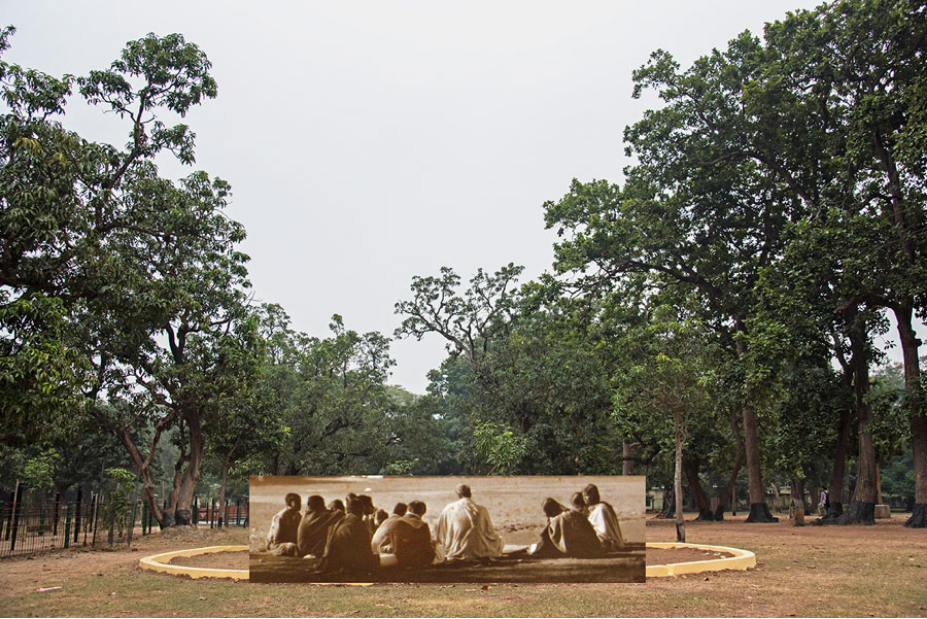Categories
- Amitesh Shrivastava
- Amol K Patil
- Anupam
- Ashwini Bhat
- Baptist Coelho
- Chirodeep Chaudhuri
- Desire Machine Collective
- Goutam Ghosh
- Hemali Bhuta
- Himali Singh Soin
- Huma Mulji
- Khageshwar Rout
- Khageswar Rout
- Mahesh Baliga
- Munem Wasif
- Neha Choksi
- Pallavi Paul
- Prajakta Potnis
- Prasad Shetty & Rupali Gupte
- Raqs Media Collective
- Risham Syed
- Rohini Devasher
- Sandeep Mukherjee
- Sarnath Banerjee
- Shreyas Karle
- Shumon
- Tejal Shah
- The Otolith Group
- Uncategorized
The Place Where India Meets the World: A New Film by the Otolith Group: FRIEZE
26 June 2018
Presented at the Rubin Museum, New York, can art offer a way of viewing nature as an actor in its own right?
We begin in a blazing world: In the opening sequence of O Horizon (2018), the Otolith Group’s latest film, as part of their exhibition ‘A Lost Future’ at the Rubin Museum in New York, flames lick the mechanical engines of excavator diggers on a forest road. ‘Today in a hundred years’, recites a voice, ‘Who are you reading this poem?’ Smoke rises toward the sky as man and machine intervene in nature. ‘What fragment of today’s joyous spring / Today’s wild flower or bird song / Today’s blood-red mood’, the voice continues, ‘Can I possibly transmit unto you?’ These lines, excerpted from the cosmopolitan polymath Rabindranath Tagore’s 1895 poem, ‘The Year 1400’, act as a coda to the film, which was researched, filmed and produced over five years in the Indian state of West Bengal. Flitting between music, dance, poetry and literature, O Horizon offers a fragmented yet engrossing view of a Tagorean ethos, one that situates modernism, cosmopolitanism and ecopolitical awareness as products of experimental modes of learning.

The Otolith Group, Santiniketan Studies (A Century Before Us II): Tapovan Study Circle, 2018, digital collage on Somerset Museum Rag paper, 34 x 51 cm. Courtesy: the artists
If this aesthetic project sounds ambitious, it mirrors the aspirational plane of Tagore’s pedagogical vision, first developed in the late 19th and early 20th centuries. Approximately 180 kilometers from Kolkata, where the film takes place, Tagore created Santiniketan – roughly ‘peaceful abode’ in Bangla – in 1901 on an ashram established by his father, the zamindar Maharshi Devendranath Tagore. Intended as a reprieve far from the maddening modernity of India’s rapidly urbanizing towns, the small co-educational facility expanded in 1921 into a college, Visva-Bharati (literally ‘where India meets the world’), which was accompanied by Sriniketan (‘abode of prosperity’) in 1922 as an institute for rural reconstruction. Tagore argued that nature and culture were not only intertwined but were linked through ecology. In contradistinction to the ‘mechanical’ mode of education that pervaded Indian schools at the turn of the century, and in bold opposition to what Tagore viewed as the militaristic and capitalist aims of the colonial West, Santiniketan operated on the ultimate ambition that education could occur in harmony with nature in order to cultivate the full potential of human experience.
Read More here: https://frieze.com/article/place-where-india-meets-world-new-film-otolith-group
